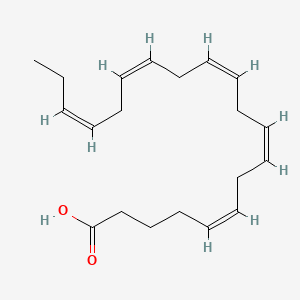| Crandell JR et al. |
Lipid effects of switching from prescription EPA+DHA (omega-3-acid ethyl esters) to prescription EPA only (icosapent ethyl) in dyslipidemic patients. |
2016 |
Postgrad Med |
pmid:27684412
|
| Kandula M et al. |
Discovery and preclinical development of a novel prodrug conjugate of mesalamine with eicosapentaenoic acid and caprylic acid for the treatment of inflammatory bowel diseases. |
2016 |
Int. Immunopharmacol. |
pmid:27716592
|
| Graciano MF et al. |
Omega-3 fatty acids control productions of superoxide and nitrogen oxide and insulin content in INS-1E cells. |
2016 |
J. Physiol. Biochem. |
pmid:27474043
|
| Fialkow J |
Omega-3 Fatty Acid Formulations in Cardiovascular Disease: Dietary Supplements are Not Substitutes for Prescription Products. |
2016 |
Am J Cardiovasc Drugs |
pmid:27138439
|
| Tian Y et al. |
Bioconversion of Docosapentaenoic Acid in Human Cell Lines, Caco-2, HepG2, and THP-1. |
2016 |
J Oleo Sci |
pmid:27829615
|
| Harris M et al. |
Membrane Disordering by Eicosapentaenoic Acid in B Lymphomas Is Reduced by Elongation to Docosapentaenoic Acid as Revealed with Solid-State Nuclear Magnetic Resonance Spectroscopy of Model Membranes. |
2016 |
J. Nutr. |
pmid:27306897
|
| Elorinne AL et al. |
Food and Nutrient Intake and Nutritional Status of Finnish Vegans and Non-Vegetarians. |
2016 |
PLoS ONE |
pmid:26840251
|
| Luo T et al. |
Consumption of Walnuts in Combination with Other Whole Foods Produces Physiologic, Metabolic, and Gene Expression Changes in Obese C57BL/6J High-Fat-Fed Male Mice. |
2016 |
J. Nutr. |
pmid:27489005
|
| Cinelli G et al. |
Influence of Maternal Obesity and Gestational Weight Gain on Maternal and Foetal Lipid Profile. |
2016 |
Nutrients |
pmid:27314385
|
| Barden A et al. |
n-3 Fatty Acid Supplementation and Leukocyte Telomere Length in Patients with Chronic Kidney Disease. |
2016 |
Nutrients |
pmid:27007392
|
